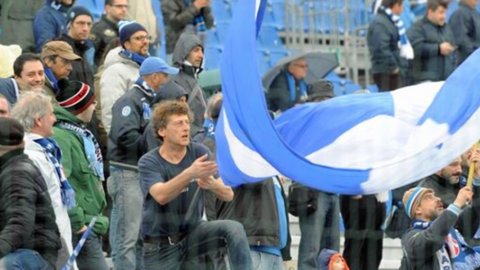Both Carpi (“Knitwear”) and Sassuolo (“Ceramic tiles”) figured fully in the Italian map of “clusters” – groups of companies – published by Michael Porter in his famous The competitive advantage of Nations (1990): their economic strength as the seat of two of the best-known Italian industrial districts comes from afar. From the next championship, the fact is widely known, both towns in the province of Modena will play, with their football teams, in the Serie A championship. It is never superfluous to remember how the first has only 70 inhabitants, the second even 40 thousand: even put together less, much less than the Municipality of Modena (180 thousand).
Staying with the map mentioned above and looking at it from the Serie A angle, the geographical concentration of "clusters" along the Via Emilia - which is the distinctive feature of the map of Italy published by the Harvard Business School professor - will unfortunately lose a protagonist ( Parma, "Food Cluster") but, perhaps, he will find another one (Bologna, "Packaging Machinery"), perhaps after the playoffs given the defeat suffered by the Bolognese last Saturday in the fundamental match against Frosinone.
Much has already been written, in recent weeks, on the "tale of Carpi", after the "miracle of Sassuolo" was celebrated two years ago; the most attentive observers have highlighted the affinities between these two exceptional Emilian performances, as well as the differences. The dominant theme - staying up to date - is rightly the skill of the Carpi management in having known how to build a team that plays excellent football on a reduced budget (he scores goals and takes very few), making the parsimonious use of resources the characteristic dominant.
Both the major national press - significantly, not only the sports press but also the general information press (three long articles were published in the "Corriere della Sera", "Il Foglio" and "Il Fatto Quotidiano") - and the local press think of the widely circulated city weeklies, "Voce", "Tempo" and "Notizie") have praised the company and sports executives - above all, Stefano Bonacini, Claudio Caliumi, Fabrizio Castori, Cristiano Giuntoli - and of course the team, where some young talents stand out and we will certainly hear a lot about them.
In a 2015-2016 Serie A championship that will start with Andrea Agnelli and Massimiliano Allegri's Juventus chasing their fifth consecutive championship, the "Derby dei Distretti" - Carpi vs. Sassuolo - will certainly be one of the most interesting and richest events of suggestions that go beyond the strictly football sphere. Of course, in terms of ... stadiums, the game for the Carpi players is, so to speak, lost from the start: the solidity, from all points of view, of the Mapei Stadium in Reggio Emilia is matched by the small (and unsuitable for Serie A) Sandro Cabassi (just over 4.000 seats).
The most probable hypothesis, at the moment, is that Carpi will go to play in Modena, but in the city an intervention in record time is not excluded to try and equip Carpi with a facility capable of welcoming, in compliance with all safety regulations, at least 10.000 spectators. We will see. And we will certainly see – apart from the stadium issue – a good game, between a team in its third consecutive championship in the top flight and a brilliant newly promoted team.
Two teams that plastically will be able to tell the country – here we are at the teaching that goes beyond football – that the Italy of industrial districts is not dead, as instead has been told for all the decades of the turbo-finance domination. What's more: they will tell the country that the economy made up of interconnected SMEs located in a given territory (the Carpi district has about 900 enterprises, of which only 300 are involved in the final phase of production while the others in all intermediate and support phases: see the essay What happened to the Emilian model?, which I published in the magazine "Il Mulino", n. 1/2015, pp. 105-115) is a type of economic organization that still has much to say in the time of globalization.
The counter-evidence? In its focus on Emilia-Romagna (March 2015), the District Monitor, an appreciated quarterly publication edited by the Intesa Sanpaolo Studies and Research Department, tells us that the "Sassuolo Tiles" district exported a good 2014 million in 2.847,1 euros while that of the "Knitwear and clothing of Carpi" 613,4. They are placed, respectively, in first and fifth place in the export ranking of the 20 Emilia-Romagna districts (over 11 billion in total exports), in turn among the most important in the country.
For the record – economic and, at the same time, sporting – it must be said that the “Bologna packaging machinery” district is worth 2.477,3 billion in exports (second in the regional ranking, right after Sassuolo). In short, three would be a stellar Derby!
A final consideration concerns the Modenese district which … does not exist; or, better, it isn't in the two things we talked about: the 1990 Porter map, next year's Serie A. But the "biomedical" district of Mirandola exists - and how, if it exists - in the manufacturing Italy of these very difficult years following the great crash of 2008 and, as far as these lands are concerned, following the earthquake at the end of May 2012 The city of Mirandola - which is part of the Diocese of Carpi - was hit and scarred by the earthquake in a terrible way, and more than Carpi, more than Modena, more than Sassuolo.
And yet, the Mirandola biomedical district (Intesa Sanpaolo prefers to call it a "technological pole" to distinguish it from the "traditional" ones such as fashion, tiles, mechanics, etc.) has already completely restarted, also thanks to new and innovative investments. Even in Mirandola they won their championship, the most difficult of all: that of reconstruction.





